Delhi: Greater Kailash
This is a collection of articles archived for the excellence of their content. |
Contents |
Greater Kailash I
Built: Post-1950
The Times of India, Jul 05 2015
GK-1 was developed soon after Independence to meet the growing demand for houses from Punjabis and the refugees from Pakistan. DLF sold the 2,700 plots in the colony in the 1950s for Rs 16 per square yard but construction didn't start till the 1960s. In the 60 years since, the price of land has increased to Rs 5 lakh-Rs 7 lakh per sq yard
Civic issues
2017
AlokKNMishra, Victims of their own affluence, Mar 29, 2017: The Times of India
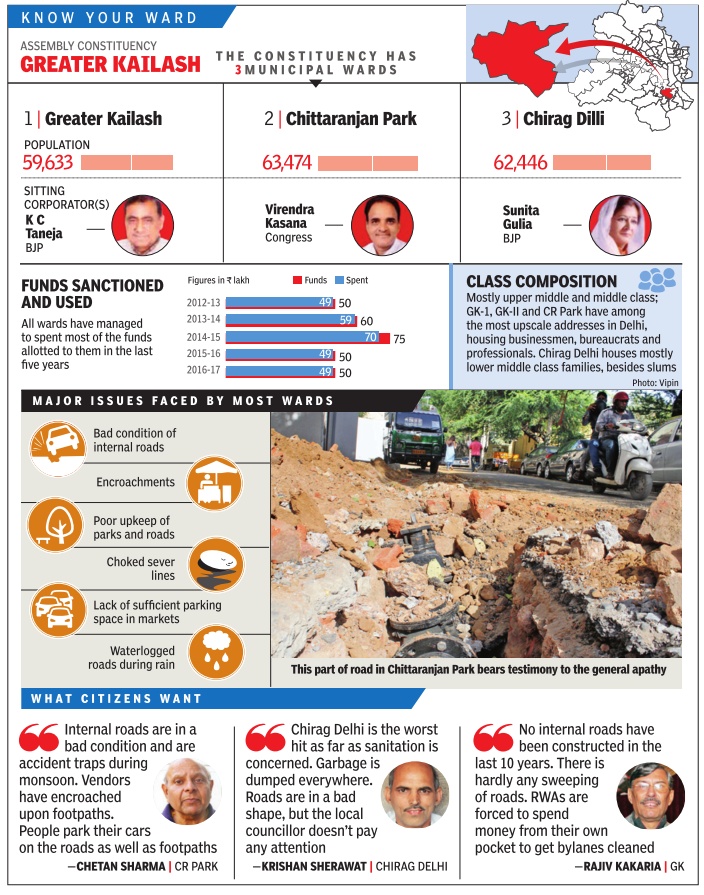
Pavements Taken Over By Vehicles, People
The affluent colonies of Chittaranjan Park and Greater Kailash sit incongruently with their organised appearance against their neighbour Chirag Dilli's overflowing dumps, malodorous, uncovered sewers and unplanned houses opening on to shrunken lanes. But beyond economic demarcations, people in these three wards -the existing fourth ward of Shahpur Jat was subsumed into the three after delimitation -are equally unhappy .
Of these South Delhi Municipal Corporation wards falling in the Greater Kailash assembly constituency , Greater Kailash and Chittaranjan Park are unsuccessfully battling the takeover of pavements by people and vehicles, while Chirag Delhi continues to struggle for basic civic amenities like sanitation, drinking water and healthcare.
The problem of encroachment in CR Park and GK stems ironically from the economic status of the residents. As Gautam Banerjee, shop owner in CR Park Market 2, explained, “Around 40 years ago, with mostly single-floor bungalows, the roads were free of encroachment. The growth in the number of multi-storeyed bungalows, residents and cars has led to encroachments.“
Another aspect of this statusdriven problem is expressed by Rakesh Saxena, who runs an eatery in GK. Pointing to the construction waste dumped on the footpath near a big house, Saxena said, “The VIP residents consider themselves immune to action by the corporation and merrily violate all rules.“
Their clout hasn't got the residents good colony roads though. “Pits as deep as eight inches are common on every lane here,“ pointed out Chetan Sharma, chairman of GK2 Complex RWAs. His counterpart in GK1 added that in a decade now, no internal road had been relaid. Virender Kasana, the sitting Congress councillor, had this pre-election reassurance: “The fight between BJP and AAP delayed the sanction of funds. But money has now been released, and work will start after the polls.“
Parks, unlike roads, have undergone a big change, said Sachin Dutt. Shahid Bhagat Singh Park behind Dutt's second-floor flat in Kalkaji DDA Flats, like the 250 others in CR Park, now has a rain shelter.Many have been fitted out as open gyms too.
However, some voters, like Rajiv Kakaria of GK, observed, “Green waste management in parks and rainwater harvesting are not on the prio rity list of the councillor.“
A kilometre from CR Park, waste management worries thousands of people.
“The water supplied carries a whiff of sewage with it,“ complained Mohan Kumar of Harijan Mohalla in Chirag Dilli. And despite many resi dents saying that incumbent councillor Sunita Gulia of BJP has done a lot since 2012, the plaint of Manish Sharma, member of Chirag Dilli RWA, was, “Whether you approach our area from the north or south, overflowing dhalaos will greet you.“
Market

The Times of India, Jul 05 2015
Risha Chitlangia & Richi Verma
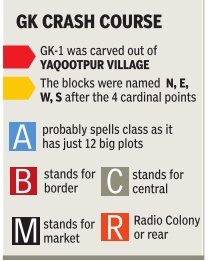
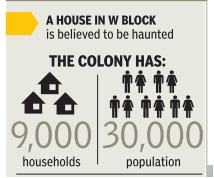
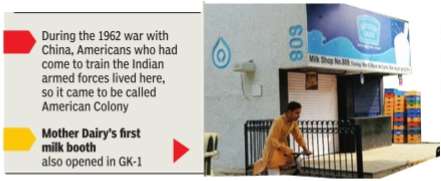
Big brands and basics, all in one place
M-block was planned on the lines of Khan Market with 73 residential-cum-commercial plots but it started out quietly and slowly with just a handful of daily needs stores: Prince Paan, New Empire Store, Morning Store, Bengali Sweets, Laxmi Store and Mahindra Store.
There were houses on the market's first floor for the families of shopkeepers. Om Prakash Aggarwal's father and uncles bought their plot in 1972 and started a franchise store of Snowhite Drycleaners. “In those days, only rich people got their clothes drycleaned. As it was a rich people's colony , we had a large clientele,“ says Aggarwal, who has now rented out a portion of his property . Aggarwal wasn't the only one to scale down his business. As big brands made a beeline for the market in the 1980s, pushing up rents, many of the low-margin and daily needs stores sold out or shrank their footprint for the new entrants. In its heyday , the M-block market housed a large number of designer labels. Rents rose to several lakh rupees a month, and the original owners chose to live the good life on rental income.Although most big labels have now moved to the malls, rents in M-block still range from Rs 2 lakh to Rs 5 lakh a month.
Not everyone went with the flow, though. Tejinder Singh Arora, owner of Mahindra Store, still sits at his counter every day. It used to be a shoe shop with a flour mill in the backyard. Now, Arora sells crockery and appliances.
Ajay Goel's Bengal Sweets has shrunk with space for just three tables, but its barfi and gulab jamun remain popular. Old-timers still prefer it to the fancy restaurants. “We rented the shop in 1965 and bought it two years later. My father was very attached to this place and we had many good years before business dipped. Today , our main income is from rent but we remain in the sweets business for sentimental reasons,“ says Goel.
Rents peaked in the mid-90s and then started declining as the mall-craze swept Delhi and NCR.“With neither parking nor other basic facilities here, it became difficult to do business,“ says D K Mehra, chairman of M-block Market Association. “In the past few years, the pattari market (hawkers) has thrived. Today , it is mainly a pattari bazaar. Despite repeated complaints, the municipal corporation has not placed checks on hawkers. There's no plan to solve the parking problem. A few hundred metres away , Nblock market has had a better run.It was developed as a commercial district with 18 plots in the 1970s, and for the next 20-odd years had only grocery stores, some banks and an ice cream parlour.
At the start of the retail boom in the mid-90s, some major retailers and high-profile restaurants set up shop in N-block. By 2002, the market had become a onestop destination for high-profile customers. Manish Gupta's family bought a plot in 1967 and ran a grocery for almost 30 years before starting a leather goods showroom. “Today , N-block is entirely a home decor and cotton retail market. In the evenings, most cus tomers come to the high-profile restaurants,“ he says.
Space costs Rs 1,000 sq yard per month in N-block, while in M-block the rentals are around Rs 700 sq yard. “That's because we cater to an elite, rich clientele and serious buyers,“ adds Gupta who is president of the trader association in N-block.
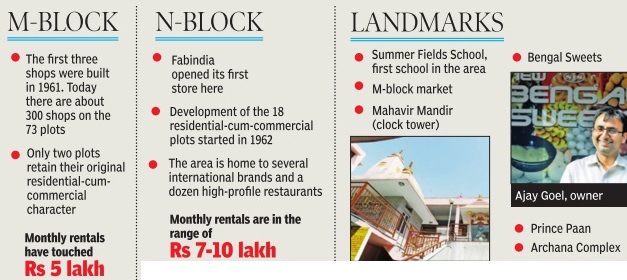
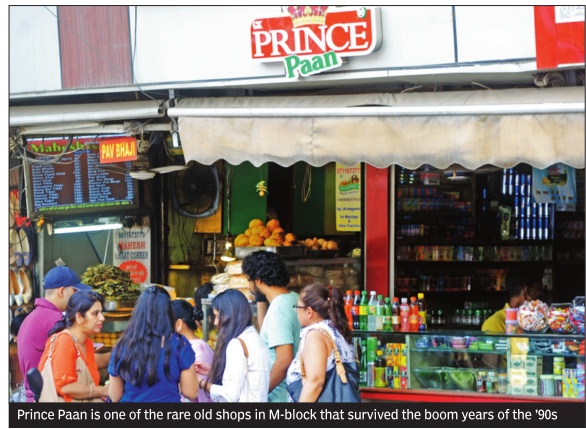

Nandan Van
Paras Singh, Nandan Van makes its debut at GK, December 9, 2018: The Times of India
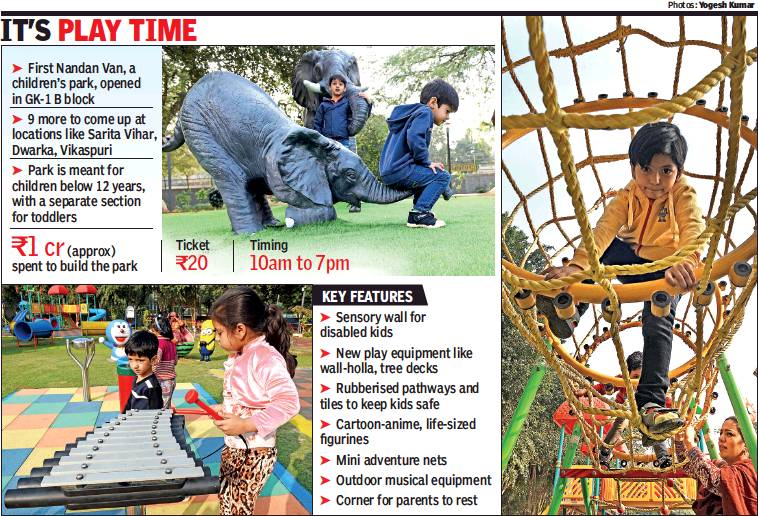
From: Paras Singh, Nandan Van makes its debut at GK, December 9, 2018: The Times of India
With tree decks, multi-play equipment, innovative swings and slides, and colourful cartoon-anime characters dotting all over its green carpet, South Delhi Municipal Corporation’s first Nandan Van, a children’s park, in B block of Greater Kailash-1 was thrown open for public.
“We hope that children of age up to 12 years from all over Delhi will have fun here,” area councillor and standing committee chairperson Shikha Rai said.
In 2015, the Delhi high court had issued directions to the civic bodies to create space where children could play safely. In a 2016 study, Delhi Commission for Protection of Child Rights also expressed the same view.
A horticulture department official said a nominal entry fee of Rs 20 had been kept so that people didn’t loiter around unnecessarily. Only children and an accompanying guardian will be allowed to enter. The DDA plot was not in use before SDMC took it over last year and completed the project in nearly six months.
Though small in size, the park is dotted with interactive spaces to engage children physically and mentally. “Some of the features like wallholla, tree decks and adventure nets serve as playful means of physical exercise, while board games and floor games, abacus joints engage them mentally,” said Alok Singh, director of the horticulture department. A small corner for outdoor musical equipment has also been created while old floor games like stapu have been carved out on a rubberised platform.
Separate corners, artistic gazebos and walkways have been included in the design to help the guardians keep an eye on the children. Commisioner Puneet Goel said the park adhered to international safety norms. “The play areas have special rubberised under-surface to prevent any chance of injuries. SDMC’s focus, as in European countries, is to turn a regular play space into a sensory park allowing various activities.”
The park also has a sensory wall for disabled kids along with a section for toddlers. “The sensory wall allows them to touch, feel and explore the underwater sea world. Shapes and sizes of fishes have been carved out on this dedicated wall,” an official said.
Sudha Juneja, a visiting parent, said they had been waiting for the park for several months. “It is not an adventure park but a good place to come with children and let them play.”
Greater Kailash II
Groundwater issues
As in 2020
Vibha Sharma, September 1, 2020: The Times of India

From: Vibha Sharma, September 1, 2020: The Times of India
In some ways, the mystery of the flooded basements in Greater Kailash II has been solved. The interim report of Central Ground Water Board, which conducted a ground survey in coordination with Delhi Jal Board, ruled out any leakage of water supply lines and said the construction of Delhi Metro tunnels and basements deeper than four metres could be obstructing the free flow of groundwater.
“The groundwater movement in the area happens from south (Jahanpanah City Forest, which is a recharging zone) towards northwest (Savitri Flyover). During a survey of the area on August 19, we found the underground water level available between 2.5m and 6.5m below ground level (bgl) while the maximum depth of residential basements facing the seepage problem was 6m bgl. The bore wells indicated further rise of average 0.5m in water level after rain on August 23-24,” the CGWB report said. DJB was asked to stop water supply for 36 hours, but there was no change in the situation, leading the surveyors to realise that the construction of metro tunnels and basements deeper than 4m was obstructing groundwater flow. “Since it is a rocky area and has very poor capacity to hold water, little rain or obstruction in outflow of water can lead to rise in water level,” the report stated.
Sanjay Rana, president, GK II RWA, added, “CGWB also said that after a portion of the road outside Greater Kailash Metro Station caved in in July 2018, DMRC did deep grouting below the road to avoid a recurrence, but this affected free flow of groundwater.”
DMRC denied a role in the problem. “We haven’t received the CGWB report, but it should be noted that when constructing around 100km of underground sections in the capital, DMRC has never come across such an issue,” stated Anuj Dayal, executive director, corporate communications, DMRC. “Near GK (near Savitri Flyover), metro tunnels have been built 10-15m below ground and the water table is below the tunnel. Also, tunnelling work was completed more than two years back and the problem has arisen now. However, we are open to addressing any complaint sent to us.”
CGWB has recommended draining water from existing horticulture tube wells or shallow points in the area with heavy pumping till water levels declined to 7m. It suggested the drained water could be supplied to water-deficit areas. The report also prescribes repairing and cleaning of stormwater drains. DJB officials, however, could not provide any update on the matter.
Residents had also approached Akhilesh Singh, senior scientist and former general manager of Indian Institute of Coal Management on the matter. Learning of construction influencing the aquifer connectivity, Singh said, “There is a need to immediately install high capacity pumping stations at Tikona Park, Sehgal Market I park and Rock Garden.”